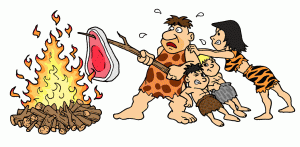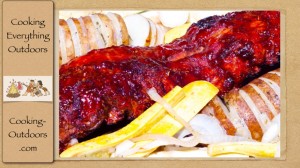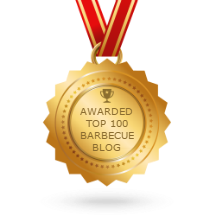Firepit BBQ Ribs and Spiral Cut Pineapple Video
It's back to the fire pit to cook up some delicious Rotisserie BBQ Ribs and Spiral cut Pineapple over a live fire using the Grizzly Spit portable rotisserie.
(Closed Captioning available on this video)
You can find more information about the Grizzly Spit Rotisserie in my review: Grizzly Spit Portable Campfire Rotisserie Kit
Video Transcript:
Presenter:
Hey, everyone, today rotisserie ribs, pineapple all on the Cooking Everything Outdoors show.
Gary House with the outdoor cook Cooking Everything Outdoors show, I hope you try this at home.
So I want to talk to you a little bit about my fire pit set up.
As you can see here I have just retaining block stone or retaining stone block that I’ve knocked the lip off of.
I’ve used 36 stones to give me the perimeter of my fire pit.
As far as wood goes I’m using almond or if you live here it’s amond.
And these are really 3-4-year dried almond logs that I’m using in it.
And I think it produces a nice sweet, hardy smoke and a really good charcoal that’s very similar to oak, in my opinion, it retains its heat and substance for a long time.
Using about 6 logs here to get my charcoal base and I’ll be adding a log as we go throughout the cooking process.
Now to cook our ribs we’re going to be using a rotisserie.
And I’ll be using the Grizzly Spit which is a battery-operated rotisserie.
Great for camping, great for the backyard, if you don’t want to run an extension cord or your fire pit is too far away from the almond, if you know what I mean.
And it’s very, very simple device.
It comes with 2 support rods.
Nice heavy-duty spit.
The power pack which is battery-operated with couple of the batteries.
And I think it’s 2D cell batteries.
And also comes with a couple of the spit forks that’s going to hold the ribs on.
And as I get the rib rack on, then I’m going to be adding the pineapple, a whole pineapple, as we cook a little bit further into it.
So that’s the set up.
And that’s what we’re going to do on top of our almond coals.
So far baby back ribs you’ve seen me prepare this before, I’ve taken the membrane off the back, washed and patted them dry.
And now I’m going to apply a honey mustard binder.
I’m going to make sure that we get a light coating of our binder on all surfaces.
Let’s get our rub on there.
We want to rub on all surfaces.
This has had a nice brown sugar base to it.
Salt and dried onion.
A little bit more on there.
Okay, I’m going to let this set for a little while 15 or 20 minutes.
My coal base is getting set.
And then we’re going to spit it and start cooking it.
So now we need to skewer it with our spit.
And we’re basically going to weave it on the barbecue spit through the bones.
And it’s important that we use to 2 of these.
I’m going to go on each end of the spareribs and that’s going to keep it from spinning on the rod because as it cooks, you know, the meat will loosen up around the spit, pretty soon you’ll have the spit just spinning by itself.
Yeah, maybe 4.
And I want my ribs towards the motor side, rotate properly.
That’s it.
Look at those beauties.
So we have a good coal base working here.
And then I have my logs building up more coals.
So I have my spit rods in place.
And what I’ve done is the…this one here is just a little bit higher than this one.
And the reason for that is, is this is where the motor goes.
And this attaches very, very simply.
And what I want to prevent is the spit walking out of the motor.
And putting on a pair of gloves because it’s very hot.
I wish I had a…oops…I had a fireman suit on right now.
Let’s get our ribs in place.
Make sure everything’s stable and sturdy and we’ve got a little bit of a slope.
Let’s get them cooking.
Well, our ribs had been cooking for about an hour and you can see we’re starting to get some shrinkage.
But still a lot of moisture in there.
And I’m not sure this will probably take…I don’t know…we’re getting some pullback on the bones, maybe another hour or so to go here.
We’re just going to have to watch it.
If it looks like its going to dry out, then we’ll baste it.
If not, I’m going to put a sauce on it towards the end there so that we’ll get that flavor that we’re looking for, but you can see just how unique this is.
We’re getting a lot of the juices that are dripping out right now.
We may lose some moisture.
So I’m going to keep an eye on it and determined whether I want to use a base and all I’m going to use a…baste…all I’m going to use for that is some barbecue sauce that I’m going to thin down with some beer and it’s just going to help keep it moist and seal it in as it glazes over.
So be real, real nice.
Alright, so on our ribs I’m getting some really good pullback on these and that’s…you know, as you know that’s one of the ways of telling how ribs are done when you get 1/4 inch to 3/8 of an inch pullback on your ribs…rib bones, the meat pulling back from the bones, that’s when you know.
But the other way you can do is you could tempt your ribs, if you just go in between the bones, the center of the meat, and take a temp you’re looking for about 185-195 and that varies depending on your personal taste.
I mean, you can go 220 if you want it to literally fall off the bone here.
So, we are at varying temperatures.
I’m at 160 over here and this is 185 and so, you know, I’ve adjusted the heat over just a little bit but I think it’s time to start saucing up.
These are going to come up to temp pretty quick, this side here with the heat directly over that and less here.
And I want to keep this moving so I don’t lose too much juices.
It just keeps self-basting itself.
I haven’t done any basting whatsoever on this.
And we just want to hit this as it rotates.
And this is going to add that extra dimension on there that it’s just going to be phenomenal.
And this sauce is going to glaze over.
And we’ll try to get a couple of coatings on there as this cooks.
Before everything else is finished we need to get our pineapple ready, it’s the last thing I’m going to cook.
Take off the bottom.
I will take off the top.
And then I want to just skin this cap as best I can.
And I don’t want to lose a lot of my pineapple.
We’re going to spiral cut these eyes out.
Now if you haven’t seen this or tried this, it’s really pretty cool.
When you look at pineapple and you really pay attention to the eyes you realize that they are pretty much all in a line and it’s pretty amazing.
So, basically what you would do is you’re just going to cut a V as best you can.
I like to use a little paring knife and we’re pretty much just going to cut these eyes out like that.
We’re just going to work these eyes out as best we can.
So here you can see our spiral cut pineapple, if you will, and most of the eyes have come out of that and looks pretty neat.
And what I want to do now before I thread it onto the spit, and I’ve decided that I’m going to cook this separately from the ribs, is that I’m going to put on 3 things.
Very light coat of Pico de Gallo which is hot.
And I really mean to like coat, don’t get too carried away with this.
This stuff is phenomenal on fruit.
And then I want to give it a really good coating of cinnamon and sugar.
And this is just going to release so much additional flavor.
It’s going to be ridiculous.
I’m going to set this aside.
And then I’m going to pull everything else and we’re going to start cooking our pineapple and let everything set while that’s cooking.
So I’m going to officially declared that the ribs are done.
And we’re going to pull them and take a look.
They’ve pulled back from the bone very nicely.
And they look as tender as can be.
They’ve got a nice beautiful barbecue sauce glaze with that layer underneath of the rub.
And that is going to be some mighty fine eating.
Now that our main meal is finished I want to get our pineapple going.
It’s as simple as taking the rod and forcing it through the center.
And at some point you’re going to have to force it all the way through without putting a hole in your hand.
And align that up somewhere around the middle.
I want to get my forks on there.
Tighten them up.
Get them on the spit…no, they’re on a spit…get them in the fire pit.
And I get over here and grab my pineapple because this is a thing of beauty.
Dinner served.
Hey, I hope you enjoyed this episode of the Cooking Everything Outdoors show.
But without my sponsors none of this would be possible, Camp Chef and www.OutdoorCooking.com and Island Grillstone at www.IslandGrillstone.com.
Two great companies with really fantastic products.
Go visit them.
Go say hi and go buy something.
If you want to find out more about me, you can find me on Pinterest, Facebook, Twitter, YouTube, iTunes, and of course, www.Cooking-Outdoors.com where I’m always coming up with something crazy and new.
This is Gary House.
And I will see you when I see you.



what kind of shovel is that & who sells them?
Marshall, it is called a trenching shovel and it is primarily used for digging sprinkler trenches (Or used in Fire Pits).